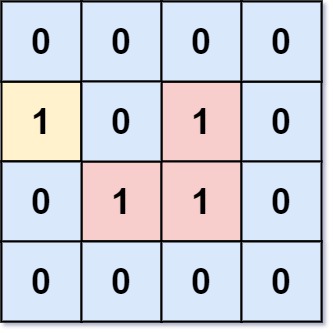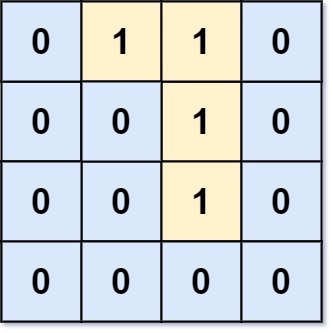Problem
You are given an m x n binary matrix grid, where 0 represents a sea cell and 1 represents a land cell.
A move consists of walking from one land cell to another adjacent (4-directionally) land cell or walking off the boundary of the grid.
Return the number of land cells in grid **for which we cannot walk off the boundary of the grid in any number of *moves***.
Example 1:

Input: grid = [[0,0,0,0],[1,0,1,0],[0,1,1,0],[0,0,0,0]]
Output: 3
Explanation: There are three 1s that are enclosed by 0s, and one 1 that is not enclosed because its on the boundary.
Example 2:

Input: grid = [[0,1,1,0],[0,0,1,0],[0,0,1,0],[0,0,0,0]]
Output: 0
Explanation: All 1s are either on the boundary or can reach the boundary.
Constraints:
m == grid.lengthn == grid[i].length1 <= m, n <= 500grid[i][j]is either0or1.
Solution (Java)
class Solution {
private void walk(int[][] a, boolean[][] visited, int x, int y) {
if (x >= a.length || x < 0 || y >= a[0].length || y < 0) {
return;
}
if (visited[x][y]) {
return;
}
if (a[x][y] == 0) {
return;
}
visited[x][y] = true;
walk(a, visited, x - 1, y);
walk(a, visited, x, y - 1);
walk(a, visited, x, y + 1);
walk(a, visited, x + 1, y);
}
public int numEnclaves(int[][] a) {
int n = a.length;
int m = a[0].length;
boolean[][] visited = new boolean[n][m];
for (int i = 0; i < n; ++i) {
walk(a, visited, i, 0);
walk(a, visited, i, m - 1);
}
for (int j = 0; j < m; ++j) {
walk(a, visited, 0, j);
walk(a, visited, n - 1, j);
}
int unreachables = 0;
for (int i = 0; i < n; ++i) {
for (int j = 0; j < m; ++j) {
if (a[i][j] == 1 && !visited[i][j]) {
++unreachables;
}
}
}
return unreachables;
}
}
Explain:
nope.
Complexity:
- Time complexity : O(n).
- Space complexity : O(n).